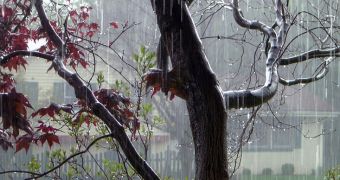In a groundbreaking new study, researchers have demonstrated a mechanism through which laser beams shot into the air can promote the formation of water droplets. According to the team of optical physicists behind the work, it could be that the technique will be used in the future to promote the formation of rainfall over a designated area. This approach varies differently from the ones used up to this point, which mostly rely on “seeding clouds” to create rain. This has been the norm in this field of research for about 50 years, Nature News reports.
Cloud seeding is a method in which small rockets are used to deliver silver iodide particles into the air. Once at various altitudes, these particles act as “condensation nuclei,” promoting the formation of small water droplets around them, which eventually fall to the ground as rain. “The problem is, it's still not clear that cloud seeding works efficiently. There are also worries about how safe adding silver iodide particles into the air is for the environment,” explains scientist Jerome Kasparian, who is an optical physicist at the University of Geneva, in Switzerland.
Together with his team, the expert now proposes using laser beams to trigger rain formation. In a paper published in the latest issue of the esteemed scientific publication Nature Photonics, the group details how firing short laser pulses into the atmosphere ionizes molecules of nitrogen and oxygen into plasma, mostly in the area around the laser beam itself. These plasma channels of ionized molecules then act as natural condensation nuclei for rain droplets, without any sort of adverse effects to the environment. The group used its Teramobile laser to study the effects of high-energy photons on the atmosphere.
They noticed that, in low-humidity conditions, the levels of light back-scattering were fairly low. This is a measure of how much of the beam is reflected back by any potential water droplets. However, the research revealed that, in high-humidity conditions, large amounts of condensation droplets were indeed forming after laser treatment. “This is the first time that a laser has been used to cause condensation outdoors,” says of the achievement laser physics expert Roland Sauerbrey, who is based at the FZD Dresden–Rossendorf Research Center, in Dresden, Germany.

 14 DAY TRIAL //
14 DAY TRIAL //